研究方向
胱抑素 D (CST5) 是一种半胱氨酸蛋白酶抑制剂,据信对口腔中的蛋白酶具有潜在的保护功能。半胱氨酸蛋白酶抑制剂 D 的抑制活性具有特异性,对组织蛋白酶 S、组织蛋白酶 H、组织蛋白酶 L 和组织蛋白酶 B 的抑制具有优先顺序。这表明半胱氨酸蛋白酶抑制剂 D 在调节特定半胱氨酸蛋白酶的活性中具有微妙的调节作用,突出了其重要性维持蛋白质稳态并可能参与口腔健康。
内毒素
< 0.1 EU/μg of the protein by LAL method.
制剂
Lyophilized from a 0.22 μm filtered solution of PBS, pH 7.4.Contact us for customized product form or formulation.
描述
Recombinant Human Cystatin-D/CST5 Protein is produced by HEK293 cells expression system. The target protein is expressed with sequence (Gly21-Val142) of human Cystatin D (Accession #NP_001891.2) fused with a 6×His tag at the C-terminus.
储存
Store at -20℃.Store the lyophilized protein at -20℃ to -80 ℃ up to 1 year from the date of receipt.
After reconstitution, the protein solution is stable at -20℃ for 3 months, at 2-8℃ for up to 1 week.未开盖的干粉蛋白在 -20°C至-80°C可保存12个月;
复溶之后,蛋白溶液在-20°C及以下可保存3个月,在2-8℃可保存1周。
生物活性
Measured by its ability to inhibit papain cleavage of a fluorogenic peptide substrate Z-FR-AM. The IC50 value is <18 nM.
复溶
Centrifuge the vial before opening. Reconstitute to a concentration of 0.1-0.5 mg/mL in sterile distilled water. Avoid vortex or vigorously pipetting the protein. For long term storage, it is recommended to add a carrier protein or stablizer (e.g. 0.1% BSA, 5% HSA, 10% FBS or 5% Trehalose), and aliquot the reconstituted protein solution to minimize free-thaw cycles.收到重组蛋白产品之后请检查蛋白冻干粉末是否贴于瓶底,如果粉末浮起,开盖之前请先低温离心。将蛋白用说明书中指定的缓冲液复溶至0.1-0.5 mg/mL(请注意蛋白复溶浓度不能低于0.1 mg/mL),室温平衡5-10 min保证充分溶解,复溶过程中请不要剧烈涡旋及吹打蛋白溶液。如需长期储存,建议复溶时添加载体蛋白或者稳定剂(如0.1% BSA, 5% HSA, 10% FBS 或者 5% 海藻糖),同时将复溶后的蛋白溶液按照需求进行分装,储存于-20°C至-80°C,随取随用,避免反复冻融。
背景信息
The cystatin superfamily encompasses proteins that contain multiple cystatin-like sequences. Cystatins are natural inhibitors of papain-like (family C1) and legumain-related (family C13) cysteine peptidases. There are three inhibitory families in the superfamily, including the type 1 cystatins (stefins), type 2 cystatins and the kininogens. As a member of type 2 cystatin, cystatin D is a single-domain protein and also has cysteine residues that form disulfide bridges. The functions of Cystatin D are largely unknown. However, Cystatin D has been shown to inhibit coronavirus replication at its physiological concentration (0.12_x005f

